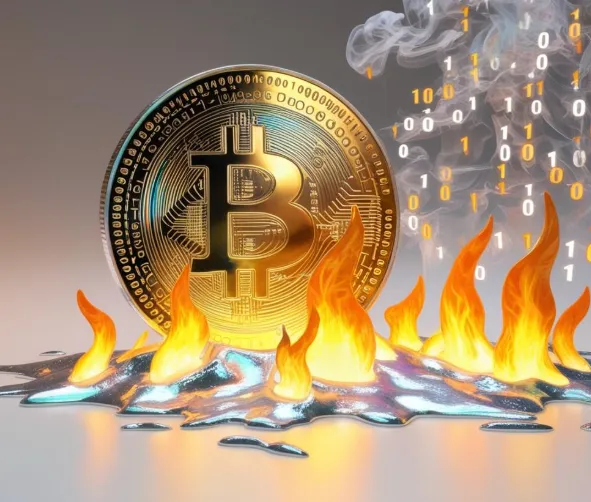Token burning is a common deflationary strategy used in the cryptocurrency world to decrease the supply of a particular token. This process can potentially increase the token’s value by creating scarcity. In this blog, we will explore what token burning is, how it works, its applications, and the pros and cons of this approach within blockchain ecosystems.
What is Token Burning?
Token burning involves the deliberate destruction of tokens by sending them to a wallet address that cannot be accessed or used. This permanently removes them from circulation. By decreasing the token supply, burning can help boost scarcity and, in turn, raise its value over time. A notable example of token burning is Ethereum’s EIP-1559 mechanism, which burns a portion of transaction fees. As of 2024, Ethereum is burning over 303,000 ETH annually through this method.
How Does Token Burning Work?
The process of burning tokens involves several steps:
- Initiation: A blockchain project or token holder decides to burn a specific number of tokens. This decision may be driven by a desire to reduce inflation, maintain token scarcity, or show long-term commitment to the project.
- Burn Amount Calculation: The amount to be burned can be a fixed number or a percentage of the total supply. For instance, if a blockchain’s total supply is denoted as S and the burn ratio is α (alpha), the number of tokens to be burned can be calculated as: Burn Amount=α×S\text{Burn Amount} = \alpha \times SBurn Amount=α×S After the burn, the new supply is: Snew=S×(1−α)S_{\text{new}} = S \times (1 – \alpha)Snew=S×(1−α)
- Execution of the Burn: Tokens are sent to a burn address (often 0x0000000000000000000000000000000000000000), which makes them inaccessible and irretrievable. This action is recorded on the blockchain for transparency.
- Smart Contract Automation: Many projects use smart contracts to automate the burning process. These contracts help to validate burn requests, adjust the total supply, and log the burn event for future reference.
The Economic Impact of Token Burning
The primary goal of token burning is to influence supply and demand dynamics:
- Supply and Demand: Burning reduces the supply of a token, and if demand remains steady, the price of the token can rise due to its increased scarcity. For instance, Binance Coin (BNB) burned $1.17 billion worth of tokens in the first quarter of 2024, cutting the supply by about 1.8%.
- Deflationary Models: Some projects burn a percentage of each transaction. For example, if a token has a 1% burn rate, every transaction results in a small reduction in total supply: New Supply=Old Supply−(Transaction Amount×0.01)\text{New Supply} = \text{Old Supply} – (\text{Transaction Amount} \times 0.01)New Supply=Old Supply−(Transaction Amount×0.01) This type of burn leads to a gradual, geometric reduction in supply.
- Proof-of-Burn (PoB) Consensus: Certain blockchain projects implement a PoB consensus mechanism, where participants burn tokens to gain the right to mine or validate blocks. In this model, the more tokens burned, the higher the likelihood of earning mining rewards.
Use Cases of Token Burning
Token burning is employed for several key reasons within blockchain projects:
- Scarcity Enhancement: Reducing the available supply of a token can create scarcity, which may increase the token’s market value over time.
- Inflation Control: Projects like Binance Coin (BNB) use quarterly token burns based on trading volume to curb inflationary pressures and stabilize the token’s value.
- Fee Reduction Mechanisms: Ethereum’s EIP-1559 mechanism burns a portion of transaction fees, decreasing the overall supply of ETH over time.
- Network Security: Some blockchains use proof-of-burn (PoB) as a consensus mechanism. In these systems, burning tokens is required to participate in validating transactions or mining, helping to secure the network while minimizing energy consumption.
Potential Risks and Challenges
While token burning can be beneficial, it also comes with risks that need to be carefully managed:
- Market Manipulation: Large token burns by a small group of holders may artificially inflate the price, creating market instability.
- Sustainability: Over-burning can limit the tokens available for transactions, which may reduce liquidity and hinder the project’s growth.
- Transaction Costs: Burning tokens involves transaction fees, and if burning happens frequently, these costs may become burdensome.
Alternatives to Token Burning
Some projects opt for alternatives to burning tokens:
- Buybacks: Instead of burning tokens, some projects repurchase them from the market, such as Crypto.com’s significant CRO burn in 2024.
- Minting Controls: Projects may limit the creation of new tokens to avoid inflationary pressures, as seen with Bitcoin’s capped supply.
Token Burning vs. Token Minting
Token burning and token minting are two opposing mechanisms that directly affect the token’s supply:
| Aspect | Token Burning | Token Minting |
|---|---|---|
| Purpose | Reduces token supply to enhance scarcity and control inflation. | Increases token supply to reward users and expand liquidity. |
| Supply Impact | Deflationary – the total supply decreases. | Inflationary – the total supply increases. |
| Process | Tokens are sent to an inaccessible wallet address. | New tokens are created through blockchain protocols (e.g., block rewards). |
| Key Examples | Ethereum’s EIP-1559, Binance Coin’s quarterly burns. | Bitcoin’s block rewards, Ripple’s XRP from escrow. |
| Risks | Overuse may reduce liquidity or destabilize markets. | Excessive minting may cause hyperinflation and devalue tokens. |
Final Thoughts
Token burning serves as a powerful strategy for blockchain projects to manage their token supply and increase value. It enables projects to control inflation, enhance scarcity, and ensure network security. While the process involves careful planning and execution, it remains an important tool in the cryptocurrency landscape. By automating the burn process with smart contracts and understanding the underlying economic models, token burning continues to play a crucial role in the success and longevity of digital assets.







